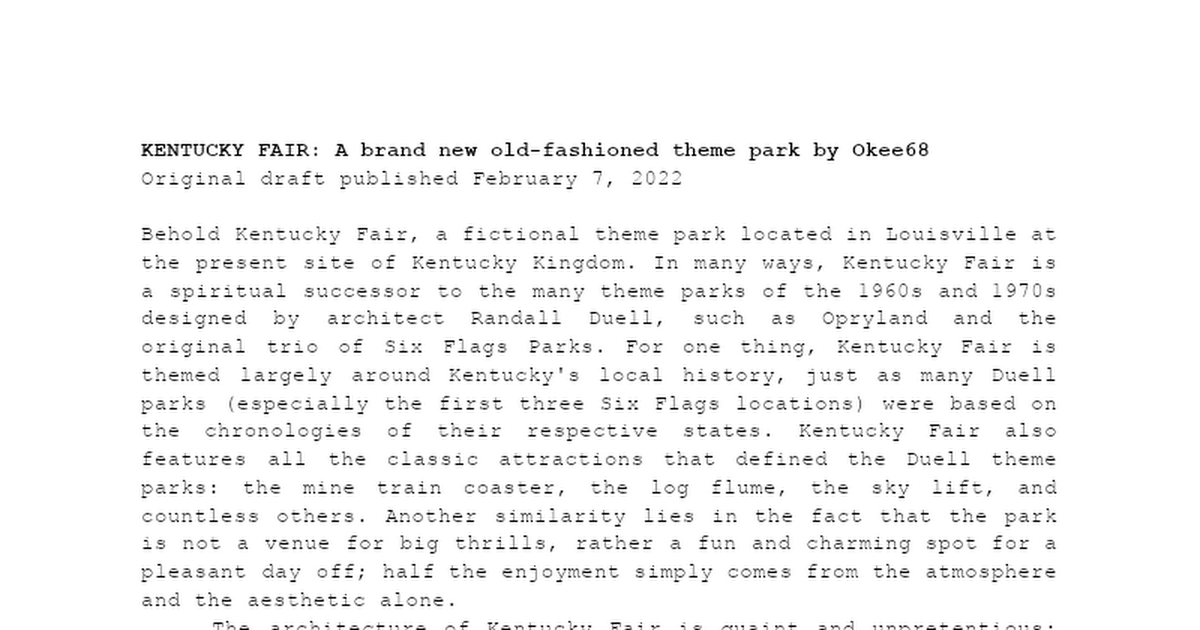GRAND BLUEGRASS EXPOSITION:
The most iconic part of Kentucky Fair, and the largest as well. The Grand Bluegrass Exposition is the first area guests visit upon entering the park, and it serves as the central point of Kentucky Fair’s Duell Loop; somebody who exits the area to the left will most likely traverse the park clockwise and re-enter the Exposition from the right, and vice-versa.
Theme-wise, the Bluegrass Exposition is a fairground scene lifted straight from the 1900s (the decade), with attractions to suit. The area is actually the least reflective of Kentucky's history out of all five. While the city of Louisville was certainly not devoid of fairground excitement and genteel public spaces at the turn of the twentieth century, the Bluegrass Exposition is mainly meant to be an aesthetic showcase with merely a light sprinkling of Kentucky culture; a pretty first impression of the park above all else.
The architecture of the Bluegrass Exposition is typical of a turn-of-the-century pleasure garden or public park: Flamboyant buildings of white-clapboard construction with hipped shingle roofs, arched arcades, lattice screens, and modest wood-carved classical detailing. Gazebos are not an uncommon sight, and some particularly stylized buildings are capped with a small, turret-roof cupola. The Exposition is also a bit of a landscaping showcase; it is more formal in this department than the other areas of the park, with lots of well-kept flowerbeds and hanging, cast-iron "birdcage" planters all around.
The Bluegrass Exposition has the most shops out of any section in the park. Among these are a large outdoor market providing a wide variety of locally grown flower bouquets, a photography shop which develops authentic old-fashioned portraits of its patrons, and a bookstore featuring an extensive selection of writings by Kentuckian authors, whether they be biographies, histories, or works of fiction. Also, each section of the park (the Bluegrass Exposition included) features a designated “general memorabilia” shop selling basic items such as ceramics, posters, mugs, decorative plates, and other such things—all themed either to the park or to the state of Kentucky of course.
Attractions
>Goldenrod Plaza: Not actually an attraction in the usual sense, but still worth listing here since all of the Randall Duell parks were designed with a grand entrance mall. The Goldenrod Plaza is the park's formal but quaint-looking entrance court featuring the standard amenities such as ticket booths, small vendors, plenty of benches, and a guest relations office. The plaza is graced with lots of colorful flora, and as its name suggests, there is most certainly a lot of goldenrod—the state flower of Kentucky. At the center of the court, a large American flag flies high above the park; a slightly smaller Kentucky flag residing just below it on the same mast.
>Equestrian Arena: Beyond the Goldenrod Plaza, the very first sight guests lay their eyes upon is the grand structure housing the Equestrian Arena, Kentucky Fair’s main representative for the state’s famous horse culture. This is a show-jumping venue in which trained horses perform impressive leaps over fences of varying heights, though not for competition. Equestrian Arena is basically Kentucky Fair’s equivalent to the dolphin shows of many Duell parks.
>Shelby Lake Swan Boats: The most prominent feature of the Bluegrass Exposition is the man-made Shelby Lake. Named after Isaac Shelby, the very first governor of Kentucky, the lake is home to a fleet of pedal-operated swan boats. Constructed of elaborately carved wood, each swan seats up to six people and features a fabric canopy for shade. Guests are free to pedal these boats around wherever they please for as long as they feel is necessary.
>Flying Thoroughbred: PTC-style carousel embellished with murals portraying Kentucky's entire history, from the very first indigenous settlers to the present day. As to be expected, each of the carousel’s wooden stallions is made to appear like a thoroughbred racing horse. Just like Opryland's Carousel On the Lake, the Flying Thoroughbred is situated on a small island off Shelby Lake and requires a wooden bridge to access.
>Kentucky Cardinal: Authentic replica of a 1900s Traver circle swing, though instead of wicker gondolas, guests ride aboard the state bird of Kentucky: the vibrant red cardinal. Each of the six stylized birds is constructed of steel and has posable wings. The radius of the swing is suspended over the lake for the most part, and the ride's central tower is veneered by white clapboard.
>Grand Bluegrass Amphitheatre: A large, open-air venue for Kentucky's iconic regional music genre: Bluegrass. This is more or less the main attraction of the Bluegrass Exposition. Bluegrass bands travel far and wide to play here, and revue-style Bluegrass stage shows are often held here as well.
>Louisville Depot: The higher-profile of two stations for the Kaintuck Railroad, the park's mandatory narrow-gauge steam train ride. The engine that departs from this depot is a narrow-gauge version of the original Dixie Flyer, a passenger train built in 1892 that operated on the Louisville & Nashville Railroad. The Kaintuck Railroad is mostly just a simple circle around the park, although much like the Six Flags Railroad at Six Flags St. Louis, it dips deep into the park's southern boundary in order to connect with the very central Louisville Depot.
Dining
>Cardinal Cafeteria: The park's largest restaurant, and the place to eat for anyone who isn't in the mood for anything in particular. The Cardinal Cafeteria is one of the only restaurants in the park in which the majority of the seating is indoors. Traditional American food is served here at a very long buffet; items include glazed ham, roast beef, mashed potatoes, buttered corn, and dinner rolls among countless other things. The cafeteria also features salad and dessert bars, as well as plenty of options for people with specialized diets.
(NOTE: All eateries in Kentucky Fair defiantly serve Royal Crown Cola and other tertiary soft drinks. There is more to life than just Coke and Pepsi.)
>Exposition Express: One of four restaurants found throughout the park specializing in standard amusement park fare: burgers, hotdogs, chili, and the like. All four of these places are counter service restaurants with the exact same menu and no indoor seating.

 docs.google.com
docs.google.com
